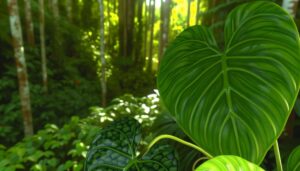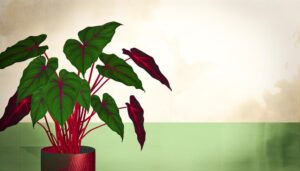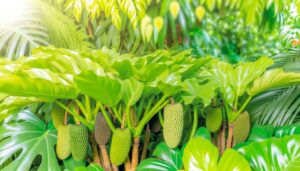What Is Philodendron Billietiae Croat?
Philodendron billietiae Croat, described by Thomas B. Croat in 1995, is a notable species from the Araceae family.
Indigenous to the lowland tropical rainforests of Brazil, French Guiana, and Suriname, it contributes significantly to neotropical flora biodiversity. This species is characterized by its large, deep green, heart-shaped leaves with unique orange petioles, which can grow up to 1 meter long.
It exhibits a vining growth habit supported by aerial roots, adapting well to humid, filtered light conditions. Understanding its specific care needs, such as substrate composition and moisture levels, provides insights into maintaining this plant successfully.
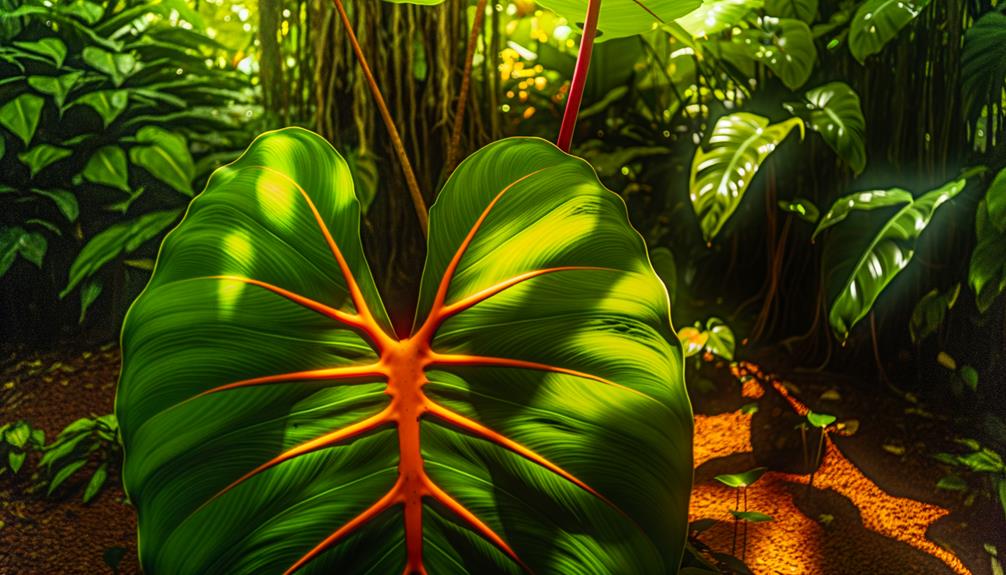
Key Takeaways
- Philodendron billietiae Croat is a tropical plant native to Brazil, French Guiana, and Suriname.
- It features heart-shaped leaves with orange petioles and can grow leaves up to 1 meter long.
- Described by botanist Thomas B. Croat in 1995, it belongs to the Araceae family.
- Ideal growing conditions include high humidity, filtered sunlight, and well-draining organic soil.
- Common pests include spider mites, mealybugs, and scale insects, managed with neem oil or insecticidal soap.
Origins and History

Philodendron billietiae Croat, first described by botanist Thomas B. Croat in 1995, is native to the tropical rainforests of Brazil, French Guiana, and Suriname. This species belongs to the Araceae family, known for its diverse and complex morphology.
Philodendron billietiae is primarily found in lowland tropical rainforests, thriving in humid, shaded understories where it clings to tree trunks as an epiphyte. Its discovery added to the rich biodiversity cataloged within these regions, highlighting the ecological significance of neotropical flora.
The epithet 'billietiae' honors Frieda Billiet, a notable plant collector. As part of the Philodendron genus, this species contributes to ongoing botanical studies, providing insights into plant evolution, adaptation, and rainforest ecosystem dynamics.
Unique Characteristics
Exhibiting elongated, heart-shaped leaves with prominent orange petioles, Philodendron billietiae Croat stands out for its distinctive morphology and vibrant coloration. This aroid species, belonging to the Araceae family, showcases leaves that can reach up to 1 meter in length.
The adaxial surface of the leaves is typically a deep green, while the abaxial surface is lighter, contributing to its unique visual appeal. The petioles, often strikingly orange, provide a stark contrast against the foliage.
Additionally, P. billietiae features a vining growth habit, supported by aerial roots that enable it to climb. These morphological traits not only enhance its ornamental value but also illustrate its adaptation mechanisms within its native tropical habitats.
Ideal Growing Conditions

Understanding the unique morphological traits of Philodendron billietiae Croat necessitates a discussion of its best growing conditions, which include high moisture levels, filtered sunlight, and well-draining soil rich in organic matter. High moisture levels, ideally above 60%, mimic its native tropical habitat, promoting prime foliar development. Filtered sunlight is essential to prevent photodamage; dappled light or partial shade is recommended. The substrate must be well-draining yet moisture-retentive, incorporating components such as perlite, orchid bark, and peat moss to enhance aeration and nutrient availability.
| Factor | Best Condition | Description |
|---|---|---|
| Moisture | Above 60% | Essential for maintaining turgor pressure and preventing desiccation |
| Light | Filtered sunlight | Prevents photodamage while allowing sufficient photosynthetic activity |
| Soil Composition | Well-draining, organic | Enhances aeration and retains moisture, vital for root health and nutrient uptake |
Watering and Soil Needs
Best watering practices for Philodendron billietiae Croat involve maintaining consistently moist soil without waterlogging. This can be achieved through a substrate blend of perlite, orchid bark, and peat moss to guarantee proper drainage and aeration. This specific combination is essential to prevent root rot, a common issue in poorly draining soils.
Philodendron billietiae requires regular watering, approximately once a week, ensuring the top inch of soil remains slightly moist but not saturated. The use of distilled or rainwater is recommended to avoid the accumulation of salts and minerals that can damage the plant. Monitoring the soil's moisture level with a hygrometer can help in maintaining the ideal hydration balance.
Proper watering and soil composition are critical to the plant's health and growth.
Common Pests and Problems
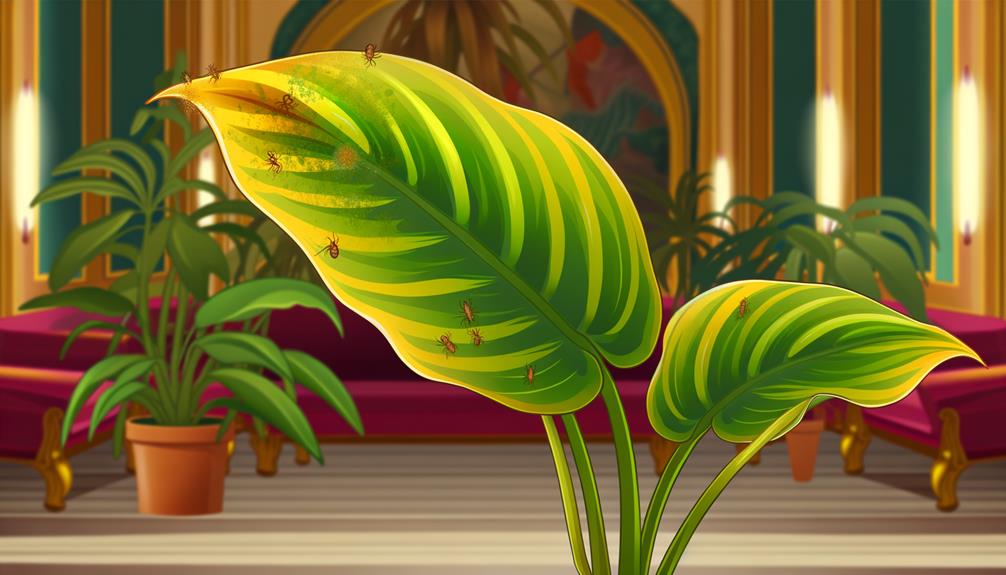
Philodendron billietiae Croat is prone to several common pests and problems, including infestations by spider mites (Tetranychidae), mealybugs (Pseudococcidae), and scale insects (Coccoidea), which can heavily affect its health if not promptly addressed. These pests typically target the foliage, leading to chlorosis, stunted growth, and potential necrosis. Early detection and integrated pest management (IPM) strategies, such as neem oil application and systemic insecticides, are vital for maintaining plant vitality. Additionally, environmental stressors like inadequate humidity and improper watering can exacerbate these issues.
| Pest | Symptoms | Treatment Options |
|---|---|---|
| Spider Mites | Chlorosis, webbing | Miticides, neem oil |
| Mealybugs | White cottony masses | Insecticidal soap, systemic insecticides |
| Scale Insects | Brown scales on stems | Horticultural oil, manual removal |
| Fungal Infections | Leaf spots, wilting | Fungicides, improved air circulation |
Regular monitoring and appropriate cultural practices are essential for optimal plant health.
Propagation Tips
Given the challenges posed by pests and environmental stressors, effective propagation techniques are fundamental for ensuring the longevity and proliferation of Philodendron billietiae Croat. Utilizing stem cuttings is a reliable method.
Select a healthy, mature stem with at least one node and aerial root. Using sterilized shears, make a clean cut below the node. Place the cutting in a sterilized container filled with a well-draining substrate, such as a mixture of sphagnum moss and perlite (Sphagnum sp., Perlite sp).
Maintain high humidity and consistent temperatures around 25°C. Root development typically occurs within 4-6 weeks. Employing a rooting hormone (auxin) can enhance root formation.
Regularly monitor for signs of rot or fungal infections, ensuring ideal growth conditions.
Conclusion
Philodendron billietiae Croat is a botanical marvel that thrives when its origins and history are respected, and its unique characteristics are understood.
Best growth necessitates specific conditions, including precise watering and soil requirements. Vigilance against common pests and maladies is essential.
Propagation, while intricate, is achievable with proper techniques. This species, when nurtured with meticulous care, rewards the cultivator with its striking foliage, making it a prized specimen in any botanical collection.


